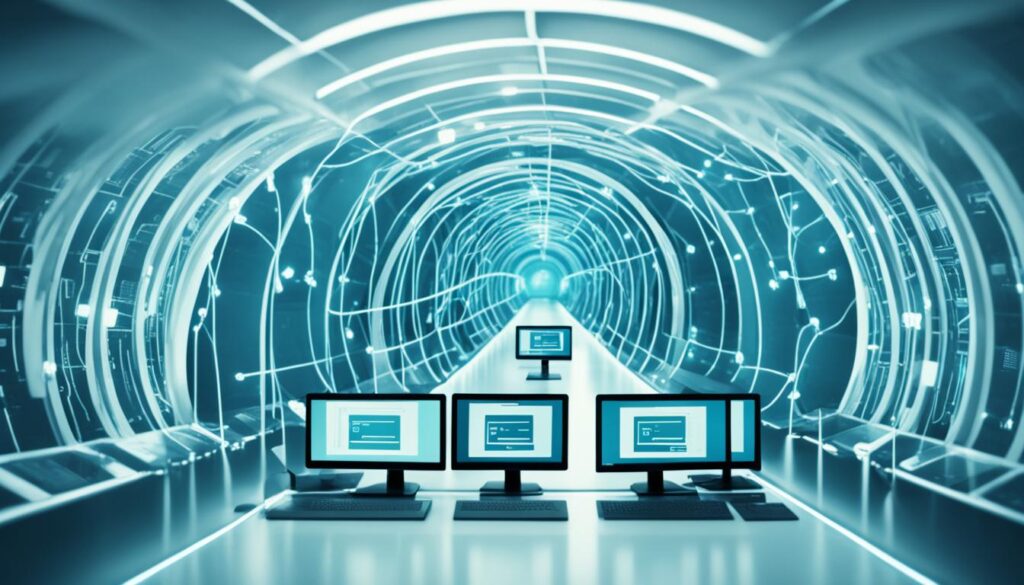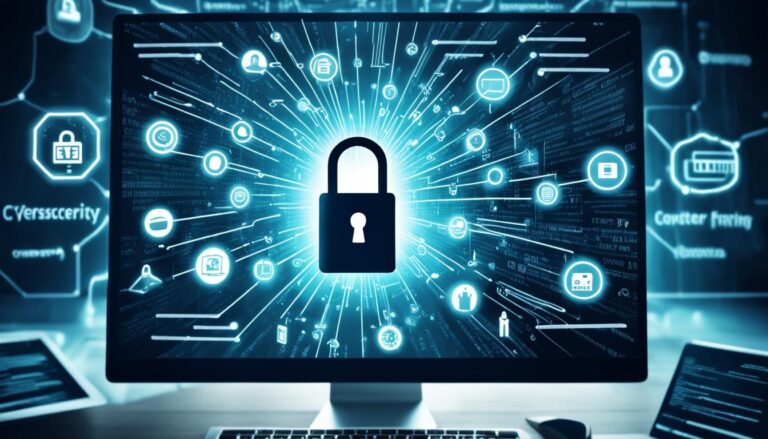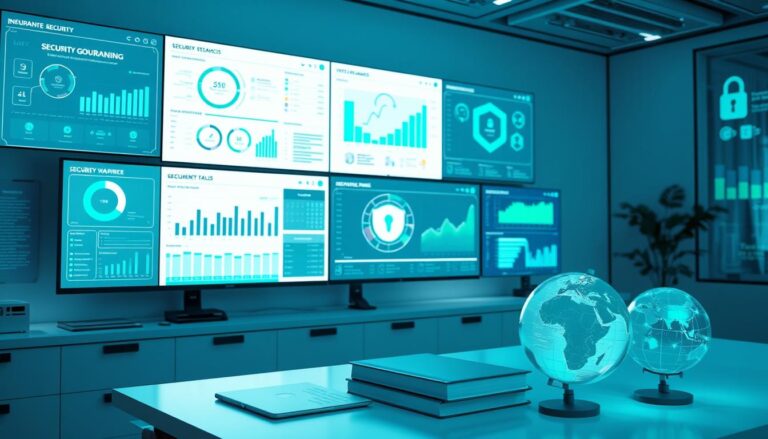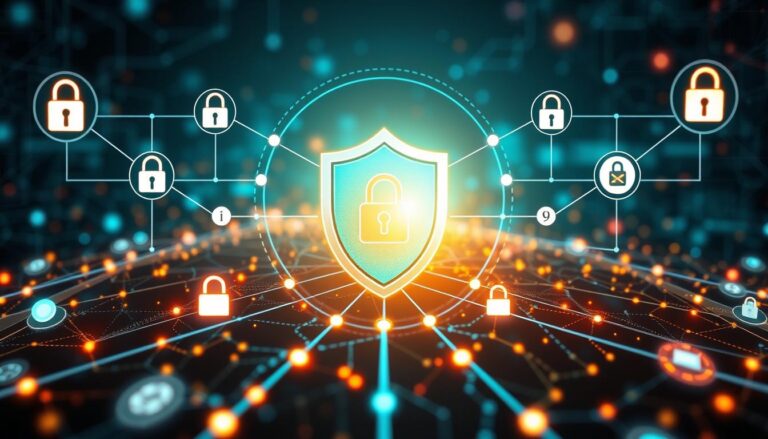
Cybersecurity is a critical concern for IT firms in today’s digital landscape, where cyber threats are constantly evolving and becoming more sophisticated. Implementing effective cybersecurity strategies and best practices is vital to protect your firm’s sensitive data and maintain the trust of your clients. In this article, we will explore actionable insights and practical steps you can take to enhance your firm’s digital defense systems.
Key Takeaways:
- Regularly update software to patch security vulnerabilities.
- Exercise caution and avoid opening suspicious emails to mitigate the risk of phishing scams.
- Keep hardware up-to-date to ensure optimal security measures.
- Utilize a secure file-sharing solution to encrypt sensitive data.
- Install and regularly update antivirus and anti-malware software to reduce vulnerability to cyber threats.
As an experienced IT professional, I have witnessed the ever-increasing cybersecurity risks faced by IT firms. Implementing effective cybersecurity measures is not only essential for safeguarding sensitive data but also for maintaining the reputation and trust of your clients. By following the best practices outlined in this article, you can proactively enhance your firm’s cybersecurity defenses and minimize the potential impact of cyber attacks. Stay one step ahead of cybercriminals and protect your firm’s valuable assets with these actionable tactics.
Keep software up-to-date
Regular software updates are crucial for maintaining a secure IT environment. Software companies release updates to add new features, fix bugs, and upgrade security. By ensuring that your software is always up-to-date, you can protect your firm from new and existing security vulnerabilities.
Outdated software can leave your IT systems exposed to security risks and potential attacks. Therefore, it is important to stay proactive by regularly checking for software updates and promptly installing them. These updates often include patches that address security vulnerabilities and strengthen your system’s defenses against cyber threats.
Additionally, software updates can also introduce improved security measures that help protect your data and sensitive information from unauthorized access. By neglecting software updates, you are essentially leaving the door open for potential breaches and compromises.
Updating your software is a straightforward process. Most software applications have built-in mechanisms that allow for automatic updates. You can also manually check for updates by visiting the software vendor’s website or utilizing update management tools.
Remember, staying up-to-date with software updates is a fundamental aspect of a comprehensive cybersecurity strategy. By consistently implementing these updates, you can minimize the risk of security vulnerabilities and safeguard your IT environment.
Why You Should Keep Software Updated:
- Enhanced security measures
- Protection against new and existing security vulnerabilities
- Improved defense against cyber threats
- Patches to fix bugs and vulnerabilities
- Access to new features and functionality
Avoid opening suspicious emails
Opening suspicious emails can expose your IT firm to phishing scams and cyber attacks. It is important to exercise caution and avoid opening emails that appear suspicious. Phishing emails often impersonate individuals or companies to gain access to sensitive information. By refraining from opening suspicious emails, you can mitigate the risk of falling victim to phishing scams.
To protect your IT firm from phishing scams and cyber attacks, here are some key practices to follow:
1. Verify the sender’s identity
Before opening an email, check the sender’s email address and verify if it matches the official email address associated with the company or individual. Be cautious of emails that have misspelled or unfamiliar email addresses, as they may be indicators of phishing attempts.
2. Look out for suspicious subject lines and email content
Pay attention to subject lines that create a sense of urgency or involve requests for personal information, such as passwords or financial details. Emails with grammatical errors, generic greetings like “Dear User,” or unusual formatting should also raise suspicion.
3. Don’t click on suspicious links or download attachments
Phishing emails often contain malicious links or attachments that can install malware on your computer or direct you to fake websites designed to steal your credentials. Always hover over links to verify their legitimacy and avoid clicking on them if they appear suspicious.
4. Be wary of requests for personal or sensitive information
Legitimate organizations typically do not request personal information, such as passwords or social security numbers, via email. If you receive an email asking for such information, contact the organization directly through a trusted channel to confirm the request.
5. Enable spam filters and email authentication
Use spam filters provided by your email provider to automatically filter out suspicious emails. Additionally, implement email authentication protocols such as Sender Policy Framework (SPF), DomainKeys Identified Mail (DKIM), and Domain-based Message Authentication, Reporting, and Conformance (DMARC) to verify the authenticity of incoming emails.
By following these practices and educating employees about phishing scams, you can significantly reduce the risk of your IT firm falling victim to cyber attacks through suspicious emails.
Remember, staying vigilant and maintaining a cautious approach towards email communication is essential for maintaining the security of your IT firm.
| Warning Signs | Indicators of Suspicious Emails |
|---|---|
| Suspicious Email Address | Email addresses with misspellings, random numbers or characters, or unfamiliar domains |
| Poor Grammar and Spelling Errors | Phishing emails often contain grammatical errors, typos, and awkward phrasing |
| Urgent or Threatening Language | Subject lines or email content that create a sense of urgency, demand immediate action, or threaten consequences if not followed |
| Mismatched URLs | Hover over links to identify any mismatch between the displayed URL and the actual destination it leads to |
| Unsolicited Requests for Personal Information | Emails asking for account credentials, social security numbers, or other sensitive data |
Keep hardware up-to-date
Outdated computer hardware can pose significant security risks for your IT firm. Aging hardware may not support the latest software security upgrades, leaving your system vulnerable to cyber attacks and data breaches. To ensure optimal security measures, it is essential to utilize up-to-date computer hardware.
By investing in modern hardware, you can enhance your firm’s ability to respond effectively to cyber threats. Upgrading your computer hardware not only improves the performance and reliability of your systems, but it also provides compatibility with the latest security updates and patches.
Keeping your hardware up-to-date ensures that you have access to the latest advancements in security technology, such as hardware-based encryption and secure boot processes. These features add an extra layer of protection to your IT infrastructure, safeguarding your sensitive data from unauthorized access.
Additionally, upgrading your hardware allows for better compatibility with security software and tools. Some security solutions may require specific hardware components or capabilities to function optimally. By using up-to-date hardware, you can take full advantage of these security upgrades and ensure seamless integration with your existing software systems.
Benefits of keeping hardware up-to-date:
- Enhanced security measures
- Better compatibility with security updates and patches
- Improved performance and reliability
- Access to the latest security technologies
- Seamless integration with security software solutions
Remember, cyber threats are constantly evolving, and outdated hardware can be a significant vulnerability in your defense system. By prioritizing regular hardware upgrades, you can strengthen your firm’s cybersecurity posture and protect against emerging threats.
Comparison of Outdated vs. Up-to-date Hardware
| Aspect | Outdated Hardware | Up-to-date Hardware |
|---|---|---|
| Security | May lack support for the latest security upgrades | Compatible with the latest security updates and patches |
| Performance | Slower processing speeds and potential system crashes | Improved performance and reliability |
| Compatibility | Limited compatibility with new software and tools | Better compatibility with security software solutions |
| Technological Advancements | Misses out on hardware-based encryption and secure boot processes | Access to the latest security technologies |
By keeping your hardware up-to-date, your IT firm can effectively mitigate security risks and protect valuable assets and sensitive information from cyber threats.
Use a secure file-sharing solution to encrypt data
When it comes to safeguarding confidential information, utilizing a secure file-sharing solution that offers data encryption is crucial. Regular email communication is not secure enough for exchanging sensitive documents, leaving them vulnerable to interception by unauthorized users. Protecting your firm’s data from potential breaches requires a more robust and secure approach.
By implementing a secure file-sharing solution like TitanFile, you can ensure that sensitive files are automatically encrypted before sharing. This encryption acts as a protective layer, making it extremely difficult for unauthorized individuals to access the data. In the event of a data breach, the encrypted files remain unreadable, providing an additional level of security for your valuable information.
Using TitanFile’s secure file-sharing solution not only safeguards your documents but also ensures compliance with data protection regulations. The encryption technology employed by these solutions adheres to industry standards, offering peace of mind when sharing confidential information with clients, partners, or colleagues.
Benefits of Using a Secure File-Sharing Solution
Implementing a secure file-sharing solution that incorporates data encryption offers several key benefits:
- Enhanced Data Security: Encryption protects sensitive files from unauthorized access and minimizes the risk of data breaches.
- Compliance with Regulations: Secure file-sharing solutions enable compliance with industry regulations, such as HIPAA or GDPR.
- Improved Client Trust: Encrypting files before sharing demonstrates your commitment to your clients’ data security, strengthening trust and fostering stronger relationships.
- Efficient Collaboration: Secure file-sharing solutions facilitate seamless collaboration, allowing team members to work on shared files in a secure and controlled environment.
- Avoidance of Data Loss: Data encryption safeguards files in case of accidental loss or theft, preventing unauthorized individuals from accessing or reading the information.
Investing in a secure file-sharing solution like TitanFile is a proactive step towards strengthening your firm’s cybersecurity defenses and safeguarding sensitive data. By adopting a comprehensive approach to data protection, you can mitigate the risks associated with data breaches and ensure the privacy and security of your firm and its clients.

Use anti-virus and anti-malware
Protecting your IT firm from malware is essential in maintaining a secure digital environment. By utilizing reliable antivirus software and anti-malware solutions, you can significantly reduce the vulnerability to cyber threats that can compromise your firm’s sensitive data and systems.
While complete protection from malware is challenging, antivirus software and anti-malware solutions act as vital defense mechanisms, detecting and eliminating various types of malware, including viruses, worms, trojans, and ransomware.
To strengthen your firm’s cybersecurity defenses, it is crucial to install reputable antivirus software that provides real-time protection against emerging threats. Regularly updating both antivirus software and anti-malware solutions ensures that your cybersecurity tools have the latest virus definitions and security patches, allowing them to effectively counter new and evolving malware threats.
By implementing comprehensive antivirus software and anti-malware solutions and regularly updating them, your IT firm can minimize the risk of malware infections and mitigate potential damages caused by cyber attacks.
Benefits of utilizing antivirus software and anti-malware:
- Protection against various types of malware, including viruses, worms, trojans, and ransomware.
- Real-time detection and elimination of emerging threats.
- Regular updates to ensure the latest virus definitions and security patches.
- Enhanced cybersecurity defenses to minimize vulnerabilities to cyber attacks.
Use a VPN to privatize your connections
A virtual private network (VPN) is a valuable tool for enhancing the security and privacy of your IT firm’s network connections. By utilizing a VPN, you can encrypt your connection and protect your private information from unauthorized access, including from your internet service provider (ISP).
A VPN creates a secure tunnel between your device and the internet, ensuring that your data remains encrypted and inaccessible to anyone trying to intercept it. This added layer of security is particularly important when accessing sensitive information, such as client data or proprietary business information.
When you connect to the internet through a VPN, your data is routed through remote servers operated by the VPN provider. This process masks your IP address and encrypts your data, making it virtually impossible for hackers or other malicious actors to intercept or decipher your communications.
Moreover, utilizing a VPN protects your privacy by shielding your internet activities from your ISP. Without a VPN, your ISP can potentially monitor your online activities, including the websites you visit, the files you download, and the services you use. By encrypting your connection with a VPN, you can ensure that your online activities remain private and secure.
Here are some key benefits of using a VPN:
- Enhanced Security: VPNs offer encryption and protect your data from interception by malicious actors.
- Privacy Protection: VPNs shield your internet activities from your ISP.
- Secure Remote Access: VPNs enable secure access to your firm’s network resources, even when you are not physically present in the office.
- Bypass Geographic Restrictions: VPNs allow you to bypass geographic restrictions and access content that may be blocked or unavailable in your region.
Using a VPN is crucial for safeguarding your firm’s sensitive data and ensuring the integrity of your network connections. By encrypting your connection and protecting your privacy, a VPN adds an extra layer of security to your IT infrastructure.
| Benefits of Using a VPN | Explanation |
|---|---|
| Enhanced Security | VPNs provide encryption and protect your data from interception. |
| Privacy Protection | VPNs shield your internet activities from your ISP. |
| Secure Remote Access | VPNs enable secure access to your firm’s network resources from anywhere. |
| Bypass Geographic Restrictions | VPNs allow you to access geo-restricted content. |

Check links before you click
Links can be disguised to appear legitimate, but they may lead to malicious websites. It is important to verify links before clicking on them to avoid falling victim to phishing scams or visiting potentially harmful websites.
One way to check the legitimacy of a link is by hovering over it on most browsers. This will display the target URL, allowing you to double-check its authenticity before proceeding.
Another precautionary measure is to verify the credibility of the sender or the source of the link. If the email or message seems suspicious or looks like it could be from a phishing source, it’s best to avoid clicking on any embedded links.
By practicing hyperlink verification, you can protect yourself and your IT firm from potential cybersecurity risks. It helps you avoid phishing links that can compromise sensitive information and lead to data breaches.
Why Is Hyperlink Verification Important?
The growth of cyber threats, particularly phishing attacks, has made hyperlink verification a vital component of effective cybersecurity strategies. Phishing scams often rely on disguising links as legitimate sources to trick users into sharing personal or financial information.
By checking links before clicking on them, you can avoid:
- Falling victim to phishing attacks
- Exposing your IT firm to malware or spyware
- Compromising sensitive data
- Becoming a target of identity theft
Tips for Hyperlink Verification:
- Hover over the link to display the target URL and verify its authenticity.
- Avoid clicking on links in suspicious emails, messages, or websites.
- Use reliable antivirus software to detect and block phishing links.
- Keep your operating system and browsers up-to-date to benefit from the latest security features.
By following these tips and adopting a cautious approach, you can reduce the risk of falling prey to phishing scams and ensure a safer online experience for yourself and your IT firm.
| Benefits of Hyperlink Verification | Examples of Potential Risks |
|---|---|
| Protection against phishing scams | Exposure to malware or spyware |
| Safeguarding sensitive data | Becoming a target of identity theft |
| Prevention of financial losses | Compromised cybersecurity defenses |
Don’t be lazy with your passwords!
Creating strong and unique passwords is crucial for ensuring the security of your IT firm’s accounts and systems. Weak passwords can make your firm vulnerable to password-related attacks and compromise sensitive data. To safeguard against potential breaches, it is important to prioritize password security and strength.
The Importance of Password Security
Password security plays a pivotal role in protecting your confidential information and preventing unauthorized access. Weak passwords that are easy to guess or common can be exploited by cybercriminals, compromising the integrity of your IT firm’s data and systems. It is essential to implement reliable password security measures to mitigate the risk of security breaches and maintain the trust of your clients and stakeholders.
Tips for Creating Strong Passwords
Follow these tips to enhance password strength:
- Use a combination of uppercase and lowercase letters, numbers, and special symbols in your passwords. This makes them harder to crack.
- Avoid using personal information, such as your name, birthdate, or address, in your passwords.
- Make your passwords at least 12 characters long to increase complexity and security.
- Consider using a password management tool to generate and securely store strong, unique passwords for each account.
To help you assess the strength of your passwords, utilize password strength-checking tools available online. These tools analyze various factors, including password length, complexity, and uniqueness, to provide insights into the security of your passwords.
Regularly Update Your Passwords
Regularly changing your passwords is another crucial aspect of password security. Set a schedule to update your passwords periodically, such as every three months or semi-annually. This practice helps minimize the risk of password-related vulnerabilities and ensures that you stay one step ahead of potential threats.
Enable 2-Factor Authentication
Your IT firm’s accounts are valuable assets that must be protected from unauthorized access. One effective way to enhance account security is by enabling 2-factor authentication (2FA). This feature adds an additional layer of defense by requiring users to provide two forms of identification before accessing sensitive information.
With 2FA, authorized individuals must go through a two-step verification process. First, they enter their username and password as usual. Then, they are prompted to provide a second form of identification, such as a unique code sent to their mobile device or a biometric scan. This ensures that even if a hacker manages to compromise the initial login credentials, they would still need the second factor to gain access.
Enabling 2FA significantly reduces the risk of unauthorized access to your IT firm’s accounts. It helps verify the authenticity of users and protects against password breaches or stolen credentials. By implementing this extra layer of security, your firm can safeguard sensitive data and prevent potential security breaches.
Take advantage of the built-in 2-factor authentication options provided by popular platforms and services. Most major email providers, social media platforms, and cloud storage services offer 2FA as an optional feature. Make sure to educate your employees about the importance of enabling 2FA and provide clear instructions on how to set it up for each applicable account. By making 2FA a standard practice, your IT firm can fortify its account security and stay one step ahead of cyber threats.






